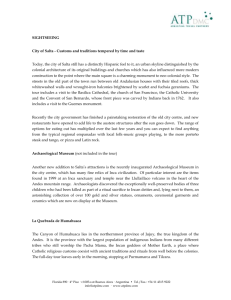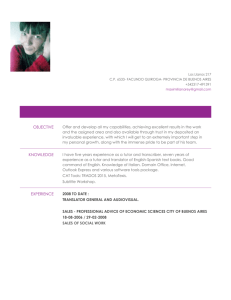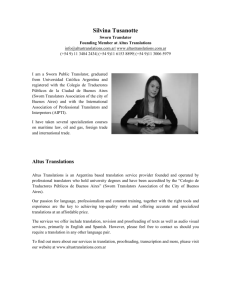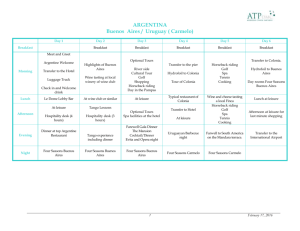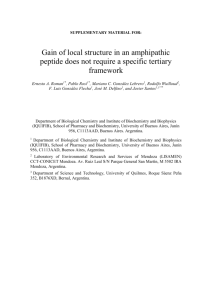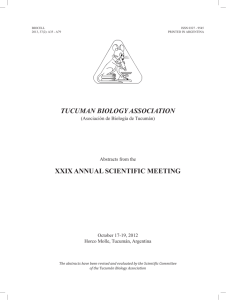northwest 5 days itinerary
advertisement
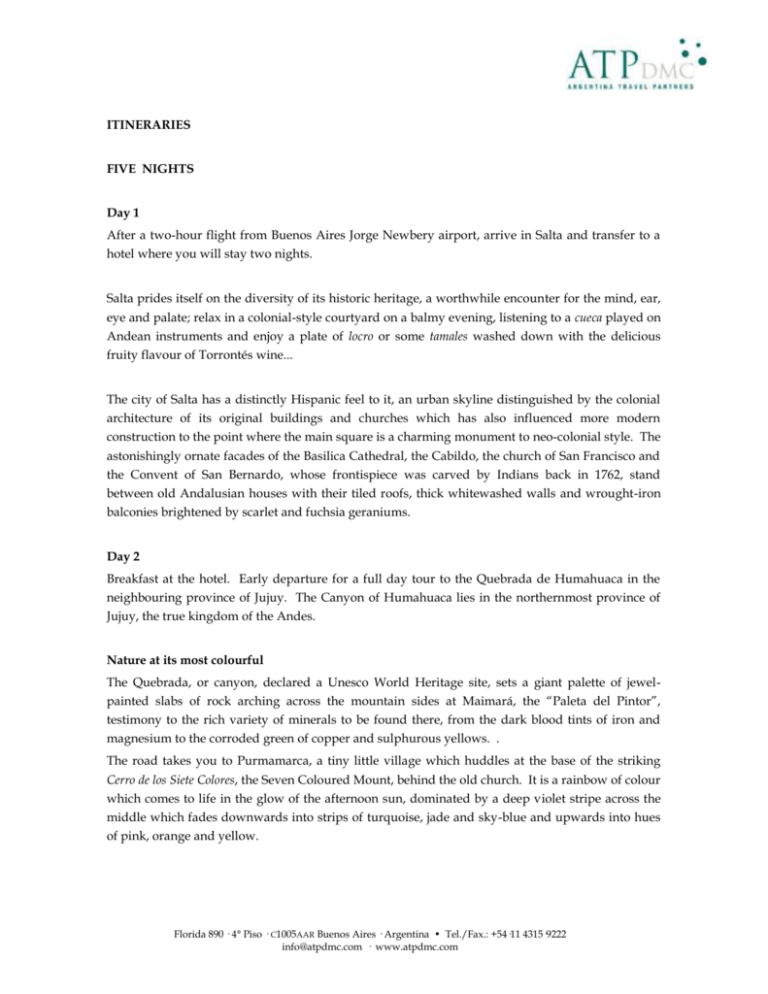
ITINERARIES FIVE NIGHTS Day 1 After a two-hour flight from Buenos Aires Jorge Newbery airport, arrive in Salta and transfer to a hotel where you will stay two nights. Salta prides itself on the diversity of its historic heritage, a worthwhile encounter for the mind, ear, eye and palate; relax in a colonial-style courtyard on a balmy evening, listening to a cueca played on Andean instruments and enjoy a plate of locro or some tamales washed down with the delicious fruity flavour of Torrontés wine... The city of Salta has a distinctly Hispanic feel to it, an urban skyline distinguished by the colonial architecture of its original buildings and churches which has also influenced more modern construction to the point where the main square is a charming monument to neo-colonial style. The astonishingly ornate facades of the Basilica Cathedral, the Cabildo, the church of San Francisco and the Convent of San Bernardo, whose frontispiece was carved by Indians back in 1762, stand between old Andalusian houses with their tiled roofs, thick whitewashed walls and wrought-iron balconies brightened by scarlet and fuchsia geraniums. Day 2 Breakfast at the hotel. Early departure for a full day tour to the Quebrada de Humahuaca in the neighbouring province of Jujuy. The Canyon of Humahuaca lies in the northernmost province of Jujuy, the true kingdom of the Andes. Nature at its most colourful The Quebrada, or canyon, declared a Unesco World Heritage site, sets a giant palette of jewelpainted slabs of rock arching across the mountain sides at Maimará, the “Paleta del Pintor”, testimony to the rich variety of minerals to be found there, from the dark blood tints of iron and magnesium to the corroded green of copper and sulphurous yellows. . The road takes you to Purmamarca, a tiny little village which huddles at the base of the striking Cerro de los Siete Colores, the Seven Coloured Mount, behind the old church. It is a rainbow of colour which comes to life in the glow of the afternoon sun, dominated by a deep violet stripe across the middle which fades downwards into strips of turquoise, jade and sky-blue and upwards into hues of pink, orange and yellow. Florida 890 · 4° Piso · C1005AAR Buenos Aires · Argentina • Tel./Fax.: +54·11 4315·9222 info@atpdmc.com · www.atpdmc.com The next village, Tilcara is slightly larger and more developed and boasts a fascinating Archaeological Museum which has several Inca mummies and other artefacts of this long-extinct civilization on display. Nearby is the pucara, or stronghold, a detailed and precise reconstruction of the original omaguaca or humahuaca Indian fort which stood there some 10 centuries ago and was only discovered in 1908. It is one of the finest examples of pre-Hispanic civilization, showing how the fortification was split up into living areas, animal corrals, a temple and a burial ground. Day 3 Breakfast at the hotel. Check out. Early departure for the Calchaquíes Valley full-day excursion to Molinos via Cachi. One of the most breathtakingly beautiful trips from the city of Salta heads west towards Cachi before dipping south to finish at the colonial town of Molinos. It is a truly unforgettable journey through a region that has witnessed turbulent times with the arrival of the conquistadores who sought to dominate and subdue the Indian tribes against a dramatic backdrop of spectacular surroundings. Behind the wind-sculpted rock formations that blaze forth in tones of red, purple and ochre, lie quiet villages in green valleys whose simple adobe and thatch houses have not changed in centuries. Molinos, elegance and history Molinos is an elegant colonial town graced with a magnificent church built in 1639 as well as the imposing hacienda of Nicolás Severo Isasmendi (1753-1837), the last royalist governor of Salta, whose mummified remains now lie in the church. Today, the hacienda has been transformed into a hotel. Near the town is Coquena, the country’s first vicuña farm which not only keeps the local weaving industry in good supply of this soft fine wool but also ensures the preservation of the species, at one time in danger of disappearing. In the town as well as in the surrounding villages, the quality of the hand-woven goods from sheep, llama and vicuña wool such as ponchos, rugs and throws is excellent. Overnight in Molinos Day 4 Breakfast at the hotel. Departure to Salta via Cafayate. Full-day excursion. Quebrada de las Flechas The road south from Molinos to Cafayate, the wine capital of the north-west, passes through the spectacular Quebrada de las Flechas -Arrow Canyon- where a forest of sharp granite spires slant up into the sky like a quiver full of giant arrows. At its entrance lies the beautiful village of Angastaco -which means carob tree eagle- and well worth visiting during Holy week for its intricate Via Crucis procession. Florida 890 · 4° Piso · C1005AAR Buenos Aires · Argentina • Tel./Fax.: +54·11 4315·9222 info@atpdmc.com · www.atpdmc.com The wines and songs of Cafayate The approach to Cafayate is flanked by billowing white dunes of glittering mica that rustle constantly as the wind sculpts them into different shapes. One of the driest spots in the country –it is said to be sunny every single day of the year- the town is famous above all for its wines and is surrounded by vineyards and wineries many of which are open to the public. However, there is always something to do in Cafayate, which offers a varied balance of cultural activities ranging from craft exhibitions and the Bravo Archaeological Museum to folk music concerts. In February, the town holds the Serenata folk festival, one of the finest in the country. Visitors also have the opportunity to rent bicycles or hire horses to visit some of the many attractions in the valley, including the cave paintings in San Isidro and the wildlife along the banks of the Colorado river, as well as the wineries. The combination of altitude, climate and terroir, together with insightful investment in technological innovation, has gained Cafayate an international reputation for the quality of its wines. The Quilmes: the fall of a warrior tribe Just a few kilometres south of Cafayate you can read another chapter in the sorry story of the extermination of the Indian races in South America. The silent stone ruins of the indigenous city of Quilmes, once one of the most important Indian settlements in the country, are all that are left of this fierce tribe of warriors that once pledged allegiance to the Emperor Huasi of the Incas and resisted the Spanish conquerors to the last. The quilmes tribe worshipped the serpent, which represented the ray of lightning that precedes the rain; the toad whose song heralded storms and the ñandú, the south American ostrich which represented the rain clouds. Quilmes, a fort founded around 1000 A.D., repelled the efforts of the colonisers for many centuries but finally fell under the siege mounted by the troops of the Viceroy of the River Plate in 1667 which left the city bereft of food and trade. Unable to communicate with other tribes or feed their children, the most influential women in the community decided that they would not surrender their freedom or that of their offspring in exchange for food and thus flung themselves and their babies off the top of the mountain. A short and unequal struggle left a handful of survivors who were taken prisoner and marched all the way to Buenos Aires, some 2000 kilometres to the southeast. Those that survived the journey were allowed to settle in the community that bears their name to this day, Quilmes, a suburb of Buenos Aires, but there took the decision that their race could not live under Spanish rule. They elected to have no children and thus died out. Today, the ruins of the Quilmes fort which lie some 50 km from Tafí del Valle in the province of Tucumán, are held to be among the finest pre-Hispanic archaeological treasures in South America. Overnight in Quilmes. Florida 890 · 4° Piso · C1005AAR Buenos Aires · Argentina • Tel./Fax.: +54·11 4315·9222 info@atpdmc.com · www.atpdmc.com Day 5 Breakfast at the hotel. Departure for Tucumán vía Tafi del Valle. Tafi del Valle The most important tourism destination of the province of Tucumán, its name comes from the Diaguita Indian phrase Taktillakta, meaning “town with a splendid entrance”. Indeed, any road into Tafi offers a magnificent view of the mountains, orchards, waterfalls and rivers surrounding the gentle hollow in which Tafi lies. Not only known for its natural charms, Tafi is also the cradle of pre-Hispanic civilization, an enigmatic and apparently highly-developed people who erected a series of 114 menhirs over 2000 years ago, some almost 3 metres tall and others carved with symbols which are strongly reminiscent of the Easter island statues. One particular monolith is carved in the likeness of a human face, very similar to those found around Lake Titicaca made by the Tihuanaco people who would have been contemporary and possibly related. In February, the National Cheese Festival is held to celebrate the famous cow milk cheese, pungent and salty, often flavoured with herbs and spices, made from fresh un pasteurized milk and entirely free of preservatives or colouring. Originally a technique introduced by the Jesuits in the early 18 th century, cheese-making in Tucumán has not changed over the centuries and is now highly valued. The cheeses are kneaded by hand, placed into moulds, pressed and salted before being left to dry. The flavour is quite unique, although some compare it to the French Cantal cheese, and is due as much to the drying process as to the micro flora present at 2000 metres and the particular cow pasture, possibly seasoned by wild aromatic herbs which only grow in this area. Tucumán, where history was made The city of San Miguel de Tucumán, capital of the province of the same name, has played a key role in Argentine history, as it was here that the Declaration of Independence was signed in 1816 in the Casa Histórica whose shabby façade has been drawn by generations of Argentine schoolchildren. The city centre is the aptly named Plaza de Independencia, with a baroque-style Cathedral on one side, and the fussy gilded Government house on the other. In the middle of the square is the imposing statue of Liberty by the unorthodox 19th century sculptress Lola Mora, surrounded by orange trees (which are never allowed to bear fruit as the provincial governor fears that they may be used adversely during official events held in the square). There are several very beautiful churches with tiled domes, in particular the church of San Francisco. Also well worth a visit, is the 9 de Julio park designed by the French landscape gardener Carlos Thays, with its lakes, green lawns, sports palace and the house-museum of Bishop Colombres, who founded the province’s first sugar industry. Tucumán is also famous for its empanadas, meat pasties seasoned with olives and raisins and baked in a wood-fired oven, and its “tortilla al escoldo”, a kind of dough bread cooked over the barbeque. Overnight in San Miguel de Tucuman Day 6 Breakfast at the hotel. Leisure time before transfer to the airport. Florida 890 · 4° Piso · C1005AAR Buenos Aires · Argentina • Tel./Fax.: +54·11 4315·9222 info@atpdmc.com · www.atpdmc.com

